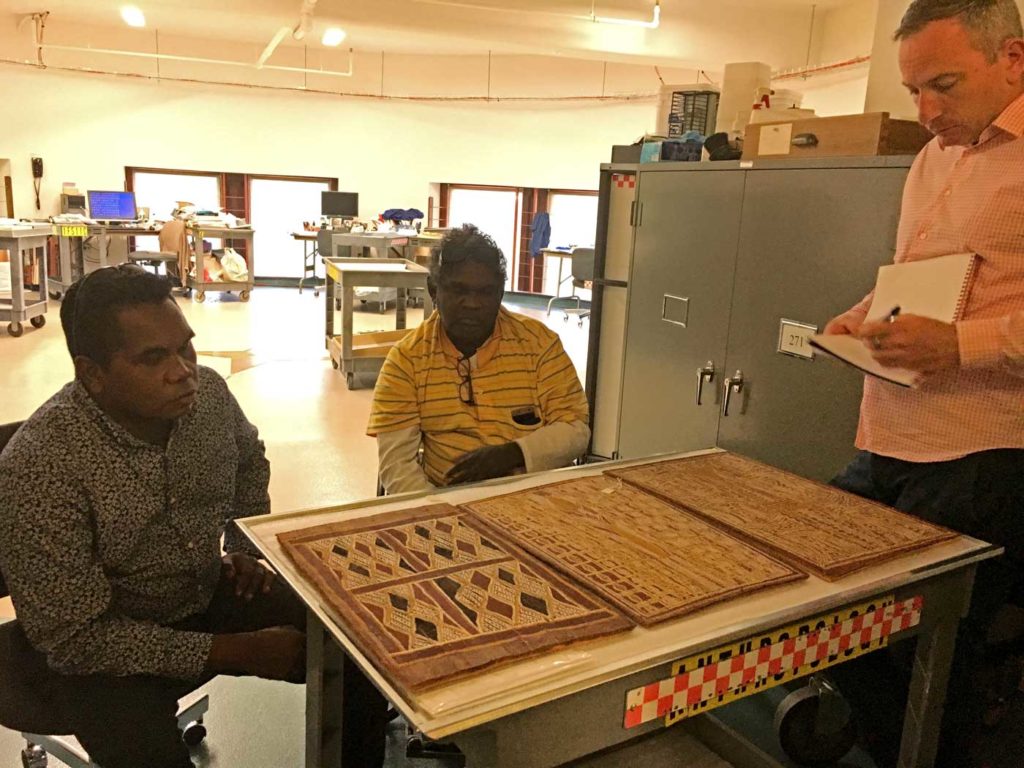When I went across to America, everything was different. Yes, especially in New York. It felt very strange to me, because it was all city, no bush. But then in the museums we saw many bark paintings, which brought my mind back to where my people come from.
Wukun Waṉambi
A bright, sunny day in New York City and everyone is feeling somewhat exhausted after the exhibition launch the previous evening, but work must go on! At 11am we meet Jacklyn Lacey, Curator of African and Pacific Ethnology at the American Museum of Natural History (AMNH) and Maia Nuku, Curator of Oceanic Art at the Metropolitan Museum at the 77th Street entrance to AMNH. In her email, Jacklyn had described it as the “canoe” entrance and rightly so: suspended in the foyer is a 63-foot canoe of the Heiltsuk and Haida Nations. Hard not be awed by the sheer scale and beauty of the “Great Canoe.”

Behind the scenes, AMNH is a labyrinth of 19th century hallways, every corner revealing weird and wonderful surprises. Finally we reach the area where Australian materials are held. We are here to look at a series of bark paintings from c.1958, collected at Yirrkala by Professors Ronald and Catherine Berndt on behalf of the AMNH. We are surprised to find that these barks have been flattened and glued onto backing boards. This has led to considerable cracking—and in some instances the glue has discolored the surface of the barks.
After having surveyed literally hundreds of paintings at Kluge-Ruhe and the Smithsonian National Museum of Natural History, Wukun has honed his classificatory short-hand. Holding court on spinning office chair, he was presented with each work, before quickly declaring paintings “real” or “tourist” paintings. For the exhibition, Wukun and Yinimala were looking for works that related to the maḏayin miny’tji (sacred clan designs), not necessarily works that expressed the artist’s individual vision:

When we went to America and went to museums going drawer to drawer, some of the paintings are real, and some of the paintings are not real—they are just paintings done for tourists. Those designs don’t come from Yolngu manikay (songlines) or Yolngu miny’tji (clan designs). They won’t take your mind back to the water, to tell you how far you can go, or your destiny to follow. I know how to curate the real paintings into an exhibition. Real paintings are not a “once upon a time” story, just made up by the artist. I’m not criticizing other people as artists—but those paintings are just how they see. So when I saw those tourist paintings I didn’t want to include them in the exhibition because they don’t say anything to me. If a balanda (non-Indigenous person) was curating the exhibition, they might have kept them in, but for Yolŋu, it’s a different understanding.
Wukun Waṉambi
Nevertheless, there are many exquisite paintings—particularly from Rirratjingu artists. A number of paintings particularly interest Wukun and Yinimala, most notably a pair of works depicting the tail of a whale. (80.1/ 3765 and 80.1/ 3823). There is some discussion as to which clan this painting belongs to, the consensus being that it is a Warramiri design related to Nanydjaka (Cape Arnhem). Another was an beautifully fine Ngaymil clan painting (80.1/ 3815)—most likely by the artist Larrtjanga Ganambarr. As with previous museum visits, Wukun and Yinimala left inspired by the cultural legacy left by their forebears.